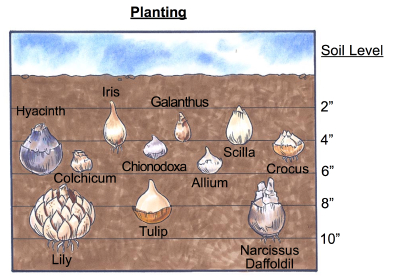We started of with a lesson in permaculture. Permaculture is the development of agricultural and horticultural ecosystems intended to be sustainable and self-sufficient. We are designing the plants in the courtyard to be self-sufficient, so with regular and diligent care, they will last throughout the year and play a useful and attractive part in the school.
Continuing on from that, we learnt some of the theory behind planting bulbs. When people hear the word 'bulbs', they usually think of daffodils, Spring, growth, new life, etc., however, what many people don't realise is that most bulbs, e.g. tulips, hyacinths and allium, are actually planted in Autumn. This is the perfect time to plant bulbs as it give their roots time to grow and prepare to support the flower as it blossoms in Spring.
The Guidelines for planting bulbs are really quite simple:
- Check the bulb's freshness by placing it in a bowl/jar of water. If it sinks, it is fresh. This is because, the older a bulb becomes, the drier it gets, making it lighter. A stale bulb will float in water.
- Dig a hole in the ground where you want to plant the bulb. The hole should be twice the size of the bulb.
- Pack in compost with the soil when refilling the hole.
We will be planting Tulips, Allium and Hyacinths in the circular flowerbed of the courtyard garden.
More commonly known as Tulips, these bright and colourful flowers originated in the Pamir, Hindu Kush and Tien Shan mountains. However, the best and most beautiful examples of tulip farms are found in The Netherlands. Holland is widely known as home of the tulips and the multi-coloured landscape of the tulip fields are a major national tourist attraction. Cultivated forms of the tulip are known as 'Dutch Tulips', which is no surprise considering the The Netherlands has the world's largest permanent display of tulips at Keukenhof, or the Garden of Europe.
 |
| Dutch Tulip Fields |
The second half of Tuesday's class involved re-modelling the flowerbed in preparation for the planting of new flowers. To do this, we had to remove all of the Japanese Flowers, and this was no easy task. These particular flowers were very tall, and had branch - like stems. To remove them, the stem had to be cut and the bulb had to be dug out. Taking the bulb out was the hardest part. After a lot of strenuous digging and teamwork, we managed to get all of the 3 inch long and 2 inch wide bulbs out of the ground, and the flower bed was once again returned to it's natural state.
 |
| Flowerbed Before |
 |
| Remains of a Japanese Flower Bulb |
 |
| Trying to dig the bulb out. |




.JPG)
No comments:
Post a Comment